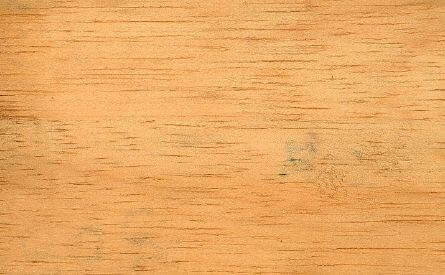White Cedar
Plumajillo / Jacaranda copaia

Local Names
Cedro Blanco, Gualandai, Chingale, Pavito, Abey, Cupay, Goebaja, Copaia, Faux Simarouba, Carabuco, Carnauba da Matta, Pará-Pará, Gallina, Fotui
Source & Tree
White cedar is found from Belize southward to Brazil and is a component of the upland forests of the Amazon region. Like San Juan, the species regenerates abundantly on old clearings. It reaches heights over 40 meters, with cylindrical more or less straight boles clear to 15 to 18 meters; trunk diameters reach up to 75 cm. Trunks are thicker at the base. The tree produces pale purple flowers and the bark is white with a sweet smell that vaguely resembles molasses, although it darkens with exposure.
Wood Appearance
The wood is a yellowish or pinkish white to oatmeal in color sometimes with brown vessel lines. Its luster is high and texture medium to coarse. It has a straight grain. The heartwood and sapwood are not well demarcated.
Processing Properties
Soft and light, the wood is easy to work. Sawn and planed surfaces may be fuzzy unless cutters are very sharp. It’s easy to peel and slice into veneer. It holds nails and screws satisfactorily, glues well and takes a good finish when sanded.
Strength & Durability
The wood is perishable in ground contact, vulnerable to rot, insect attack, and prone to blue stain. However, it has good treatability using either open-tank or pressure-vacuum systems. It compares favorably to white pine in cleavage properties and hardness.
Wood Uses
Furniture components, interior construction, decorative paneling, veneers, turnery, utility plywood, boxes and crates, concrete form work, poles, rods, matchsticks and matchboxes, fiberboard, particleboard, pulp and paper, pencils, coffins, musical instruments, and naval construction.
Non-Timber Uses
Plumajillo’s sap can be used as an adhesive, lacquer, and insect repellent.
| Reference Species | ||||
| Technical Characteristics | Plumajillo | Eastern White Pine | Yellow Poplar | |
| Density | kg/m3 | 410 | 400 | 460 |
| Janka Hardness | kgf | 181 | 172 | 245 |
| Bending Stiffness (Modulus of Elasticity) | GPa | 11.4 | 8.6 | 10.9 |
| Bending Strength (Modulus of Rupture) | MPa | 69.0 | 59.3 | 69.7 |
| Crushing Strength | MPa | 26.8 | 33.1 | 38.2 |
| Shrinkage, Radial | % | 4.5% | 2.1% | 4.6% |
| Shrinkage, Tangential | % | 6.5% | 6.1% | 8.2% |
| Shrinkage, Volumetric | % | NA | 8.2% | 12.7% |
| T/R Ratio | 1.4 | 2.9 | 1.8 | |
| Values determined at 12% humidity | ||||
|---|---|---|---|---|
DENSITY
JANKA HARDNESS
BENDING STIFFNESS
BENDING STRENGTH
CRUSHING STRENGTH
SHRINKAGE
Values are for reference only and cannot be guaranteed. Wood is a natural material and physical and mechanical properties may vary depending on age, genetics, and other factors. We encourage customers to consult the references provided in the bibliography. For further explanations of wood’s key technical characteristics, an excellent resource is the Wood Database with articles on Density (average dried weight); Janka hardness; Elastic Modulus; Rupture Modulus; Crushing Strength; Radial, Tangential and Volumetric Shrinkage.






